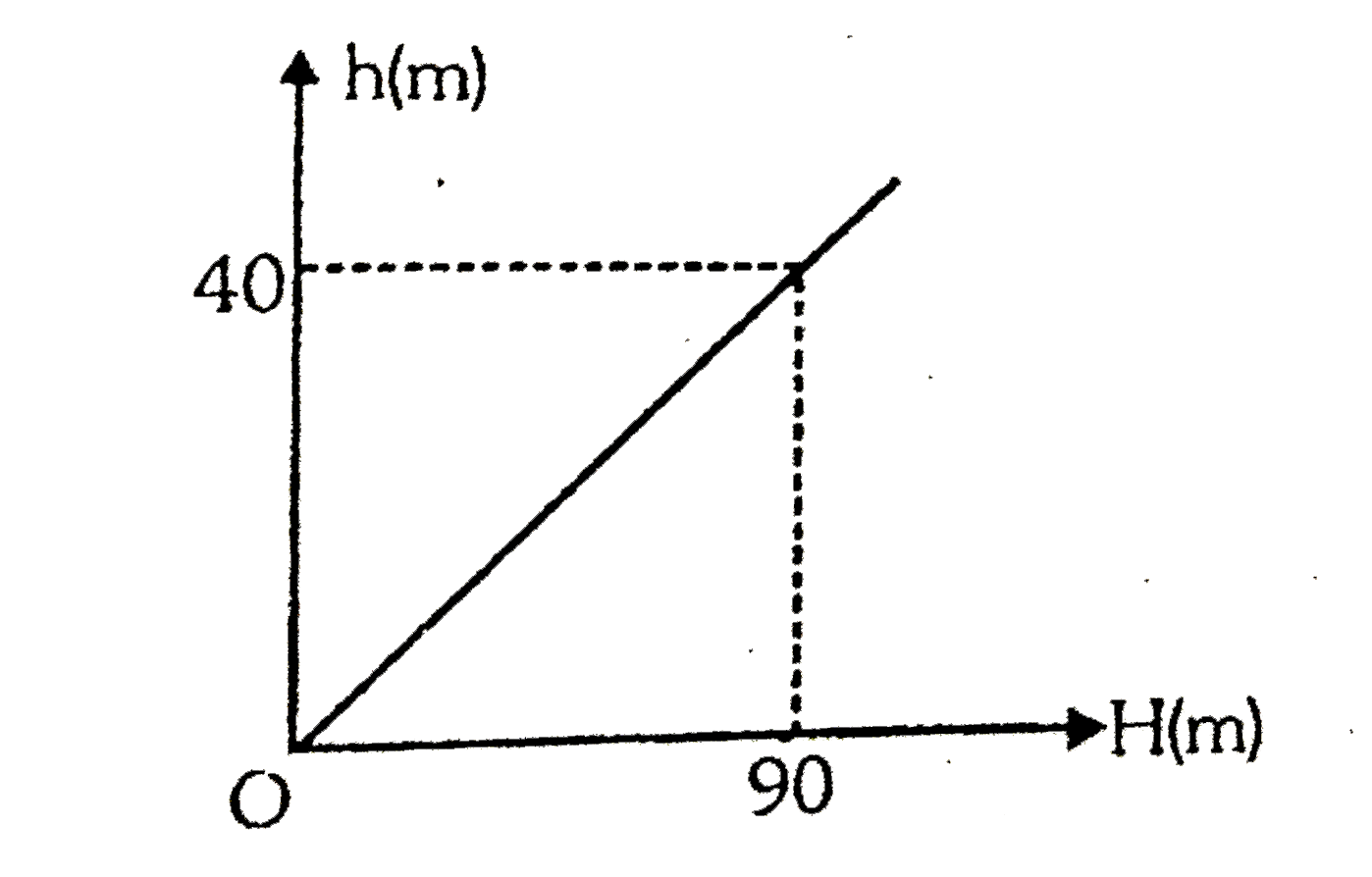A ball of mass 2kg dropped from a height H above a horizontal surface rebounds to a height h after one bounce. The graph that relates H to h is shown in figure. If the ball was dropped from an initial height of 81 m and made ten bounces, the kinetic energy of the ball immediately after the second impact with the surface was
 Solution in Gujrati
Solution in Gujrati
320J
480J
640J
Can't be determined
The correct Answer is:(A)
From graph e=√hH=√4090=23
Kinetic energy of the ball just after second bounce
=12m(e2u)2=12me4u2=e4(mgH)=(234)(2)(10)(81)=320J
Topper's Solved these Questions
- BOOK - ALLEN CHAPTER - CENTRE OF MASSEXERCISE - EXERCISE-I40videos
CENTRE OF MASS
- BOOK - ALLEN CHAPTER - CENTRE OF MASSEXERCISE - EXERCISE-II43videos
CENTRE OF MASS
- BOOK - ALLEN CHAPTER - BASIC MATHEMATICS USED IN PHYSICS &VECTORS EXERCISE - EXERCISE-IV ASSERTION & REASON11videos
BASIC MATHEMATICS USED IN PHYSICS &VECTORS
- BOOK - ALLEN CHAPTER - ELASTICITY, SURFACE TENSION AND FLUID MECHANICSEXERCISE - Exercise 5 B (Integer Type Questions)3videos
ELASTICITY, SURFACE TENSION AND FLUID MECHANICS
Similar Questions
The centre of mass of a non uniform rod of length L whoose mass per unit length varies as p=kx2/L, (where k is a constant and x is the distance measured form one end) is at the following distances from the same end
06:24View SolutionTwo particle A and B start moving due to their mutual interaction only. If at any tiem 't', →aA and →aB are their respective accelerations, →vA and →vB are their respective velocities, and upto that time WA and WB are the work done on A and B respectively by the mutual force, mA and mB are their masses respectively, then which of the following is alwys correct.
01:39View SolutionAssertion: If the initial and final positions coincide, the displacement is a null vector.
Reason: A physical quantity can not be called a vector, if its magnitude is zero.07:06View SolutionTwo soap bubbles A and B are kept in a closed chamber where the air is maintained at pressure 8N/m2.The radii of bubbles A and B are 2cm and 4cm, respectively. Surface tension of the soap-water used to make bubbles is 0.04N/m. Find tha ratio nB/nA, where nA and nB are the number of moles of air in bubbles A and B, respectively. [Neglect the effect of gravity.]
03:42View SolutionA steel ball is dropped on a hard surface from a height of 1m and rebounds to a height of 64cm . The maximum height attained by the ball after n^(th) bounce is (in m)
01:33View SolutionA ball released from a height ho above a horizontal surface rebounds to a height h_(1) , after one bounce. The graph that relates h_(0) to h_(1) is shown Fig. If the ball (of the mass m ) was dropped from an initial height h and made three bounces, the kinetic energy of the ball immediately after the third impact with the surface was
03:48View SolutionTwo balls of same mass are dropped from the same height h, on to the floor. The first ball bounces to a height h//4 , after the collision & the second ball to a height h//6 . The impulse applied by the first & second ball on the floor are I_(1) and I_(2) respectively. Then :-
03:59View SolutionA ball at rest is dropped from a height of 12 m. It losses 25% of its kinetic energy on striking the ground and bounces back to a height 'h'. then value of 'h' is
03:32View SolutionA ball is dropped from height h on the ground where co-efficient of restitution is e. After one bounce the maximum height is
04:45View SolutionA ball is dropped on a horizontal surface from height h. If it rebounds upto h/2 after first collision then coefficient of restitution between ball and surface is
02:47View SolutionA ball dropped from height h on a horizontal floor goes up to the height (3h)/(h) after hitting the floor. Fraction of energy of ball lost in the impact is
03:42View SolutionA ball is dropped on a horizontal surface from height h. If it rebounds upto height h2 after first collision then coefficient of restitution between ball and surface is
03:42View SolutionA ball is dropped from a height 'h'. If the coefficient of restitution is 'e', the height to which the ball rise after the nth rebound is:
View SolutionA ball is dropped from a heght of 3.6 m and strikes a horizontal surface . It rebounds from the horizontal surface to height h . Calculate h , if coefficient of restitution is 0.6
View SolutionA ball at rest is dropped from a height of 12 m. It losses 25% of its kinetic energy on striking the ground and bounces back to a height 'h'. then value of 'h' is
04:16View SolutionA ball at rest is dropped from a height of 12 m. It losses 25% of its kinetic energy on striking the ground and bounces back to a height 'h'. then value of 'h' is
03:06View Solution

